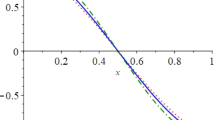Summary
A functionE:I } I → ℝ is called aquasideviation on the open interval \(I \subseteq \mathbb{R}_{\dot + } \) if
-
(E1)
sgnE(x, y) = sgn(x − y) forx, y ∈ I;
-
(E2)
y → E(x, y) is a continuous function onI for each fixedx ∈ I;
-
(E3)
y → E(x, y)/E(x′, y) is a strictly decreasing function on ]x, x′[ forx < x′ inI.
Ifx 1,⋯, x n ∈ I then the equation
E(x 1,y) + ⋯ + E(x n ,y) = 0 has a unique solutiony = y 0 which is between\(\mathop {min}\limits_{1 \leqslant i \leqslant n} \) x i and\(\mathop {max}\limits_{1 \leqslant i \leqslant n} \) x i (see [6]). This valuey 0 is called theE-quasideviation mean ofx 1,⋯, x n and is denoted by\(\mathfrak{M}_E (x_1 ,...,x_n )\).
TheE-quasideviation mean\(\mathfrak{M}_E \) is calledhomogeneous if
is satisfied for alln ∈ ℕ,x 1,⋯, x n ∈ I withtx 1,⋯, tx n ∈ I.
One of the main results of the paper is the following
Theorem.If I/I = {x/y ∣ x, y ∈ I} = ℝ+ and E:I } I → ℝ is an arbitrary function, then E is a quasideviation and \(\mathfrak{M}_E \) is a homogeneous mean if and only if there exist three functions a: I → ℝ +;f: ℝ + → ℝ, m:ℝ + → ℝ + so that
-
(i)
a is continuous and positive;
-
(ii)
f is continuous and increasing on ℝ +,further it is strictly monotonic on ]0, 1[ or on ]1, ∞[ and sgn f(x) = sgn(x − 1),x > 0;
-
(iii)
m is multiplicative, i.e. m(xy) = m(x)m(y) for x, y > 0;
-
(iv)
E(x, y) = a(y)m(x)f(x/y) for x, y ∈ I.
Similar content being viewed by others
References
Aczél, J. andDaróczy, Z.,Über veralgemeinerte quasilineare Mittelwerte, die mit Gewichtsfunktionen gebildet sind. Publ. Math. Debrecen10 (1963), 171–190.
Bajraktarevič, M.,Sur une equation fonctionnelle aux valeurs moyennes. Glasnik Mat.-Fiz. Astronom.13 (1958), 243–248.
De Bruijn, N. G.,Functions whose differences belong to a given class. Nieuw Arch. Wisk. (2)23 (1949), 194–218.
Daróczy, Z.,Über eine Klasse von Mittelwerten. Publ. Math. Debrecen19 (1972), 211–217.
Hardy, G. H., Littlewood, J. E. andPólya, G.,Inequalities. 2nd edition. Cambridge University Press, Cambridge, 1952.
Páles, Zs.,Characterization of quasideviation means. Acta Math. Acad. Sci. Hungar.40 (1982), 243–260.
Páles, Zs.,On the characterization of quasiarithmetic means with weight function. Aequationes Math.32 (1987), 171–194.
Páles, Zs.,General inequalities for quasideviation means. Aequationes Math.36 (1988), 32–56.
Author information
Authors and Affiliations
Rights and permissions
About this article
Cite this article
Páles, Z. On homogeneous quasideviation means. Aeq. Math. 36, 132–152 (1988). https://doi.org/10.1007/BF01836086
Received:
Accepted:
Issue Date:
DOI: https://doi.org/10.1007/BF01836086




